
Wait vs Stay Using a BackStall with An Over-Aroused Dog | Pt 2
This is session 2 of Wait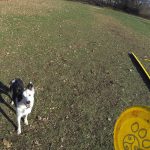 Waiting on cue and situationally is extremely important for disc dog freestyle training. The competition field might not see too much waiting going on as everything is supposed to be happening in flow,... More vs Stay via the Back Stall
Waiting on cue and situationally is extremely important for disc dog freestyle training. The competition field might not see too much waiting going on as everything is supposed to be happening in flow,... More vs Stay via the Back Stall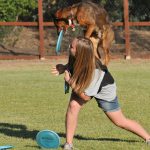 A Stall happens when your dog leaps up and stays on a part of your body. Stalls are usually named by the part of your body they happen on. If your dog leaps... More with Motown that took place a couple of minutes after session 1. In this session Motown is more calm and thoughtful and displays a bit more drive and much less arousal. We’ll be building on the stuff we covered in session 1 in this second of 4 sessions.
A Stall happens when your dog leaps up and stays on a part of your body. Stalls are usually named by the part of your body they happen on. If your dog leaps... More with Motown that took place a couple of minutes after session 1. In this session Motown is more calm and thoughtful and displays a bit more drive and much less arousal. We’ll be building on the stuff we covered in session 1 in this second of 4 sessions.
Escaping the Oppression of Offered Behaviors
As positive dog trainers we really like the dog to offer behaviors. It’s a staple of positive dog training and a real asset to dog sports, disc dog in particular.
But the constant and incessant offering of behaviors quickly leads to the oppression of the handler. We often wind up at the mercy of an aroused dog and lose control over the dog and starting behaviors and turning behaviors on and off becomes very difficult.
A well structured training session with multiple related and intersecting behaviors is a great solution to this problem. This particular set up is terrific for ending the oppression of offered behaviors.
The Calm, Cool, and Collected Trainer
Notice my demeanor in this session. While Motown is going bonkers I’m calm, cool, and collected. My cookie delivery and movements are slow and methodical. My markers are matter of fact. My cues are soft questions. I’m not trying to make him do anything.
This steady even sedate state is key to reducing arousal. I could yell at him, give him some shit and some pressure, and make him behave, but that would leave the underlying classical condition intact and, with a softer dog, shut down the training session.
Intervening with pressure also makes drive management the handler’s responsibility. It’s not fun to be responsible for your dog’s drive and/or state of arousal. It’s also not reliably effective.
It is much more reliable to cultivate a sense of self-discipline and self control in a dog. Being a calm, cool, collected handler that directly counters a dog’s highly aroused state is a good way to cultivate self-discipline and self control in a dog.
Don’t Forget Tactile Reinforcement: the Power of Touch
In the middle of this session (1:55) I take Apryl’s advice and take a moment to touch Motown. This is tactile reinforcement. You can see that it was not a very emotive touch, and on the surface it might seem as if it didn’t mean much. But if you watch closely, you might see that moment as the turning point in his performance over these 4 sessions.
Tactile reinforcement, the Power of Touch, is a powerful tool. Even for dogs who “don’t want it” or “don’t like it” and especially for dogs that are over-aroused.
This mode of reinforcement might need to be conditioned a bit and is easily done by pairing food with petting in prompt switch fashion or by pairing petting with jackpots. (perhaps a post is necessary on this…)
When delivering tactile reinforcement for reduced arousal be sure to do so in a soft, slow, easy, and methodical manner. Aggressively scruffing the dog up or even a couple of fast, repetitive strokes will work against you.
Bad Shit Didn’t Happen
During this session Motown made a couple of dick moves. His leaping up for the Stall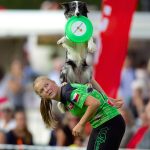 A Stall has the dog leaping up and chilling out on the handler’s back. Stalls are great for showmanship and for presenting a dog to the crowd. They create a dramatic or emotive... More, unsolicited, was dangerous to him and actually caused me a bit of an injury. It’s cool, that bad shit didn’t happen.
A Stall has the dog leaping up and chilling out on the handler’s back. Stalls are great for showmanship and for presenting a dog to the crowd. They create a dramatic or emotive... More, unsolicited, was dangerous to him and actually caused me a bit of an injury. It’s cool, that bad shit didn’t happen.
This is a tough one sometimes and many trainers think this is lunacy, that’s cool, lots of people think lots of different things, and there are millions of ways to handle a dog.
The nice thing about Bad Shit Didn’t Happen is that the bad behavior doesn’t get marked and is completely un-memorable. This un-memorable aspect is very useful when dealing with phobia or mania. Phobia and mania are not very rational and having a good solid memory of a good solid correction during a manic or panicked state might not result in effective punishment. Those moments can easily unintentionally reinforce unwanted behavior.
That shit didn’t happen and cookies happen in the right position. You can actually see him decide to not make the bad shit happen in several places in the next 2 sessions if you watch closely.
If a Behavior Isn’t Happening It Requires Moar Cookies!
The 4 on the Floor behavior on the Pedestal, in the Stall, and on the Ground is completely oppressive. It is super annoying. The tendency is to get more stingy and to pull the cookies away more often.
Reducing the rate of reinforcement and removing the cookie only serves to make each cookie more valuable. Taking the cookies away and holding them close to the dog’s face increases arousal. This creates a tough situation that can seem like a no-win.
Flooding the market with cookies devalues them. If you can find a way to deliver more cookies (in a calm, thoughtful, cool, and collected way) the value of each cookie drops and that reinforces more thoughtful work and actually punishes the constant pawing, pushing, and pressure.
Good Triggers Anchor the Structure and Create Drive
The piece on the first session with Motown talked about structure and how this session’s structure works well for addressing arousal while teaching the Stall and Dog Catch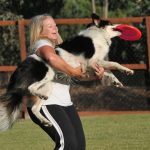 A Dog Catch is a great trick to use for hitting the crowd or for putting a strategic pause in your routine. The dog leaps to catch the disc and then you catch... More and Wait vs Stay.
A Dog Catch is a great trick to use for hitting the crowd or for putting a strategic pause in your routine. The dog leaps to catch the disc and then you catch... More and Wait vs Stay.
A big part of this structure is good solid triggers for each behavior. The trigger for the Stall on the pedestal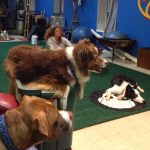 Spot is a “go to a place”, or “go to a mat” behavior. This means that the dog seeks out and performs a duration behavior on a spot of the handler’s choosing. A... More and the Off from the pedestal is the hand and/or handler movement. The Trigger for the Stall or dog catch is the presentation of the obstacle to be stalled on or the arms to be caught and/or the handler’s movement.
Spot is a “go to a place”, or “go to a mat” behavior. This means that the dog seeks out and performs a duration behavior on a spot of the handler’s choosing. A... More and the Off from the pedestal is the hand and/or handler movement. The Trigger for the Stall or dog catch is the presentation of the obstacle to be stalled on or the arms to be caught and/or the handler’s movement.
The trigger for the Wait is a lack of action or freezing of the handlers movement.
These triggers become anchor points for the structure of the training session and serve to ground and center the dog while providing focus points and clear communication necessary to take arousal and turn it into DriveDrive is focus and energy applied towards work. There are many kinds of Drive: social drive, tracking drive, prey drive, bite/kill, stalking, and food to name a few. Social drive, prey drive, and... More.





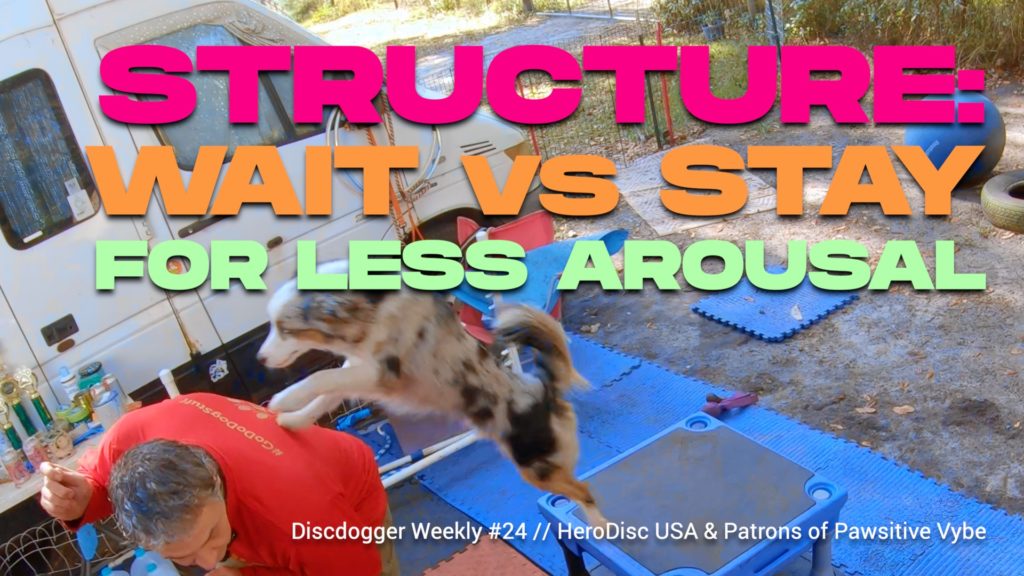
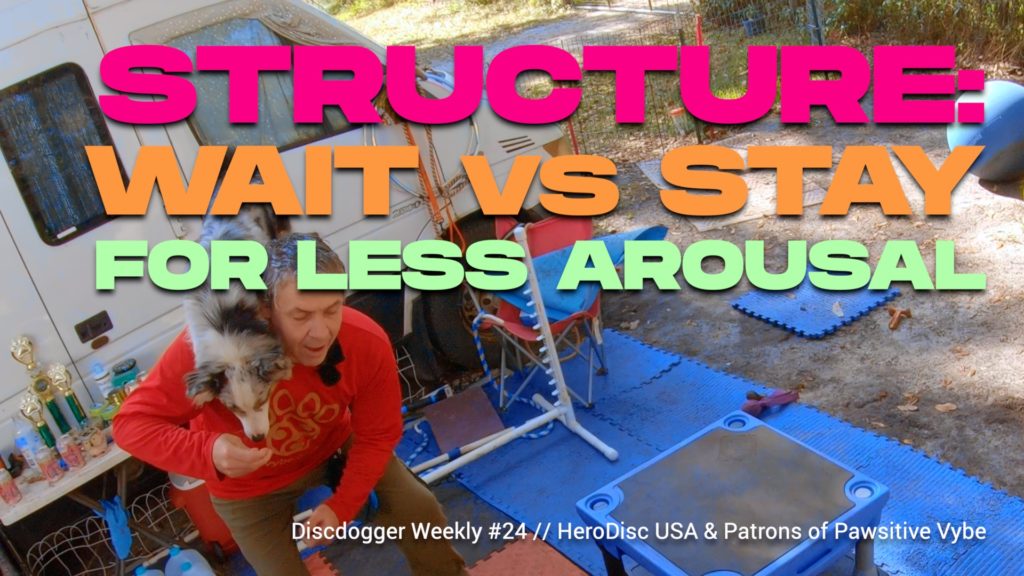
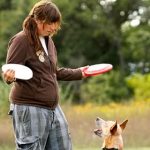


Responses